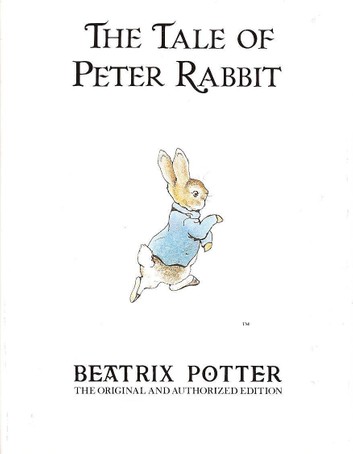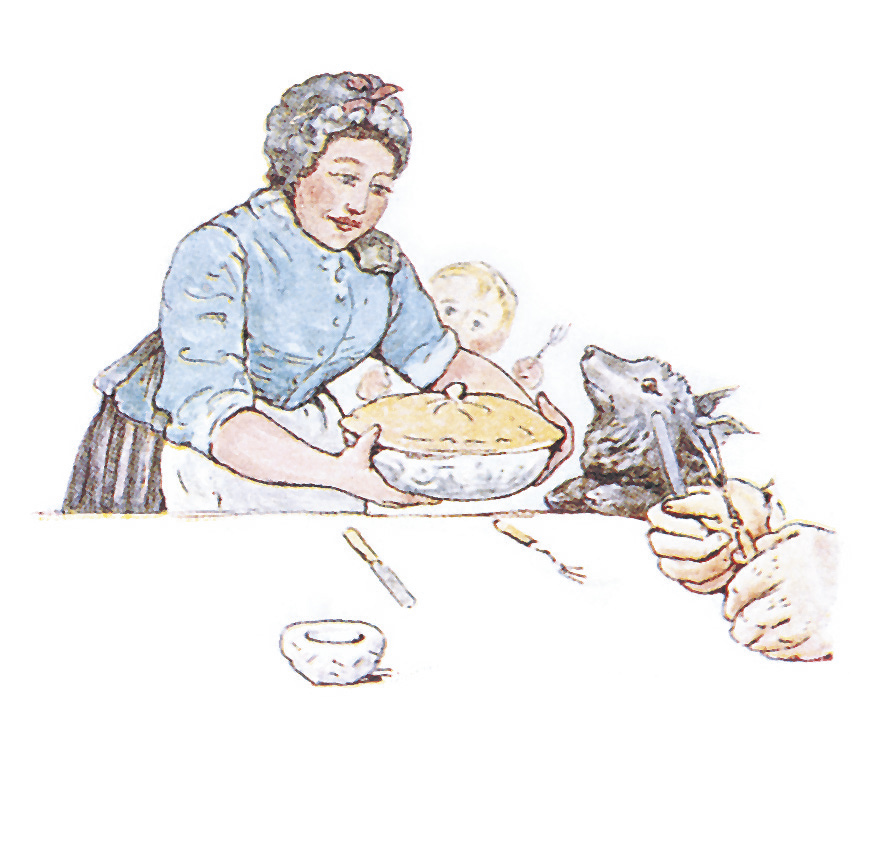The Tale of Peter Rabbit (Beatrix Potter, 1902) is a book which I have known intimately for 40+ years, having read it as a child, and then re-read it uncountable times to my own children. It is a book full of rabbits, except for one page. I am going to look more closely at the absence on this page and its significance to the overall story, with reference to Carole Scott’s chapter ‘An Unusual Hero: Perspective and Point of View in The Tale of Peter Rabbit‘ in Beatrix Potter’s Peter Rabbit: A Children’s Classic at 100

Although at first reading The Tale of Peter Rabbit appears to be a simple tale of the consequences of disobeying your mother, upon closer reading it is a much more complex text, which pits the marginalised against the dominant order. This challenge to the centre is immediate, as Peter Rabbit is told from the point of view of the marginalised non-human; the tale starts and ends with the rabbits, rather than with the human, land-owning Mr McGregor. This puts them higher in the narrative hierarchy, meaning that the reader is prompted to go away with their values rather than those of Mr McGregor. Also, the voice of the narrator, which appears to be that of ‘the powerful class and paternalistic authority of which Mr McGregor is representative’ (Scott, p.23), and who would normally be seen as the most authoritative voice, is ‘intentionally undermine[d]’ by the ‘perspective of the illustrations’ (Scott, p.26) throughout, as the illustrations present the narrative from Peter’s point of view. In this way, the text reverses the centre/margins dichotomy by allowing the marginal rabbits to take the place of the centre.
The tale opens then, with Mrs Rabbit instructing her children to stay away from Mr McGregor’s garden. The illustration on page 10 (shown below) clearly and brutally explains the reason for this admonition, and why Mrs Rabbit is so concerned that her offspring conform to this rule.

The illustration is ostensibly a happy, family scene. The traditional middle-class family is depicted, with a rosy cheeked mother and child, about to enjoy a plentiful meal, and the family dog, with nose in the air as if to inhale the aroma of the beautiful pie. This could be seen as the best that the centre has to offer; there is no sign of conflict, the family appears well fed and content. Yet, crossing the division of the white gutter to the verbal text on page 11, the reader finds that all is not as it appears. The verbal text is the voice of Mrs Rabbit, and the idea of the beautiful and attractive pie is shattered as we are told that Mr Rabbit, Peter’s father, was ‘put in a pie by Mrs McGregor’ (Potter, p.11). This, then, is the reason that Mrs Rabbit is so conformist; this is the danger of crossing the boundary between the wild woodland of the marginal characters and the owned, cultivated space of Mr McGregor’s garden.
The Tale of Peter Rabbit, Beatrix Potter, page 11
“Your Father had an accident there; he was put in a pie by Mrs. McGregor.
The written text prompts us to reexamine the illustration with an awareness of the darker aspects of the seemingly happy family meal. There is a rabbit in this picture, contrary to first impressions, and it is in the pie. The figure of the black dog, presented as a family pet begging for scraps could also be read as the ominous shaggy, black dog of many folk tales and legends (see ‘black dogs’, Simpson, 2000), which is said to be an omen of death. This can be seen as a ‘return of the repressed’, a visual reminder that the apparently happy family meal and picture of middle-class contentment depends upon the death of the ‘other’ that it disavows.
It is also significant that Mr McGregor is represented only by his hands, which appear to be very large, and signify the power and brutality they have wielded in taking a life. Perhaps the illustration also has some kind of revenge on Mr McGregor, by reducing his humanity to just a pair of hands. Of further significance, the limited view we have of Mr McGregor foregrounds the idea that there is more to this situation than the picture represents. In this way the picture draws attention to its own absences, that is, the restricted and narrow nature of the bourgeois worldview which only sustains itself by a process of rejection of the other.
Placing this illustration so close to the beginning of the tale, along with Mrs Rabbit’s warning words, means that the reader is aware throughout Peter’s exploits of the danger in which he stands, and of the contradiction of the McGregors’ attempts to exclude the marginalised rabbits, upon which they also depend to create sustenance for the happy family scene depicted. As Carole Scott states, this is a powerful critique of the ‘landed sector of society defending its borders from property-less rabble’ (Scott, p.20).
This is the situation which Mrs Rabbit understandably seeks to shield her offspring from, but to do so means accepting their marginalised and excluded position. As a whole, however, the text presents an alternative to this; Peter’s transgression, and crucially his escape, can be seen as a celebration of resistance, however dangerous, while the text’s clever foregrounding of its own absences, or the limits of its own representation, and implicitly the limits of the McGregors’ world view, serves to disrupt the authority of the centre.
Bibliography
Potter, B. (2002 [1902]) Peter Rabbit. London, Penguin.
Scott, Carole. “An Unusual Hero: Perspective and Point of View in The Tale of Peter Rabbit.” in Beatrix Potter’s Peter Rabbit: A Children’s Classic at 100. Ed. Margaret Mackey. Lanham, Md.: The Children’s Literature Association and The Scarecrow Press, Inc., 2002. 19-30.
Simpson, J. and Roud, S. “black dogs” A Dictionary of English Folklore. Oxford University Press, 2000. Oxford Reference Online. Oxford University Press.